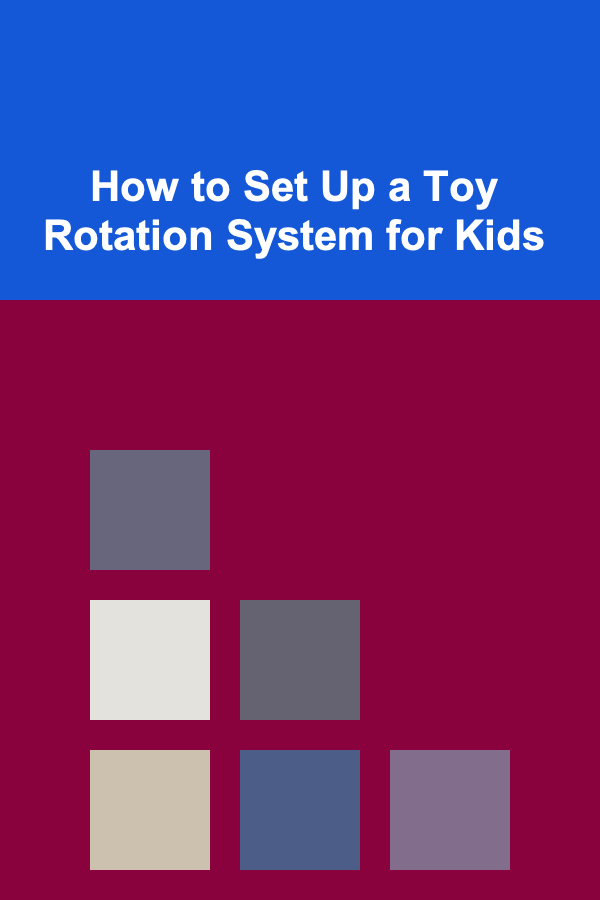
How to Set Up a Toy Rotation System for Kids
ebook include PDF & Audio bundle (Micro Guide)
$12.99$10.99
Limited Time Offer! Order within the next:

In a world filled with endless choices, children often find themselves overwhelmed by the sheer volume of toys available to them. This abundance can lead to issues such as overstimulation, lack of interest in toys, and even cluttered living spaces. One effective solution to mitigate these challenges is to establish a toy rotation system. This article will dive deep into the concept of toy rotation, exploring its benefits, how to set it up effectively, and tips for maintaining the system over time.
Introduction
As children grow, so do their interests and developmental needs. However, many parents often find themselves inundated with toys that their kids no longer play with or have lost interest in. This situation not only creates clutter but can also affect a child's ability to focus, engage in imaginative play, and appreciate the value of their toys. A toy rotation system allows parents to manage their child's toy collection effectively while fostering creativity and engagement.
In this article, we will provide a comprehensive guide on setting up a successful toy rotation system for your children, ensuring that playtime remains fresh, engaging, and organized.
Understanding the Benefits of a Toy Rotation System
2.1 Reducing Clutter
One of the most immediate benefits of implementing a toy rotation system is the reduction of clutter in your home:
- Less Mess: By limiting the number of toys available at once, you minimize mess and make cleanup easier.
- Organized Space: Fewer toys create a more organized and visually appealing environment.
2.2 Enhancing Creativity and Imagination
A toy rotation system encourages deeper engagement with toys:
- Renewed Interest: When children have limited access to certain toys, they are likely to feel excited when those toys come back into circulation.
- Focused Play: With fewer distractions, children can delve deeper into imaginative play, enhancing creativity and cognitive skills.
2.3 Preventing Overstimulation
Too many toys can be overwhelming for children, leading to overstimulation:
- Simplified Choices: A well-structured rotation reduces choice overload, allowing children to focus on what they have.
- Emotional Regulation: A calmer environment supports emotional regulation, helping children learn to manage frustration and impatience effectively.
Preparing for the Toy Rotation System
Before you can implement a toy rotation system, some preparatory steps need to be taken.
3.1 Assessing Current Toy Inventory
Start by taking stock of all the toys your child currently owns:
- Inventory List: Create a list of all toys, broken down by type (e.g., action figures, building blocks, art supplies).
- Condition Check: Examine each toy's condition---determine which toys are still usable and which should be discarded or donated.
3.2 Determining Rotation Frequency
Decide how often you would like to rotate the toys:
- Weekly or Monthly: Consider whether a weekly, bi-weekly, or monthly rotation works best for your family's schedule and your child's play patterns.
- Observation-Based: Be flexible; observe how your child engages with toys and adjust rotation frequency based on their interests.
Setting Up the Toy Rotation System
Once you are prepared, it's time to set up the toy rotation system.
4.1 Categorizing Toys
Organize toys into categories based on different criteria:
- Type of Play: Group toys into categories such as educational toys, creative arts, pretend play, and active outdoor toys.
- Age Appropriateness: Ensure that toys are suitable for your child's developmental stage.
4.2 Creating a Storage Solution
Efficient storage is essential for easy access and organization:
- Clear Bins or Boxes: Use clear storage bins labeled by category to facilitate easy identification.
- Accessible Storage: Place items at a height that your child can reach, encouraging independence in selecting toys.
4.3 Establishing a Rotation Schedule
Create a visual schedule for rotations:
- Calendar: Use a wall calendar or digital app to mark specific dates for rotating toys.
- Visual Cues: Consider incorporating charts or checklists for younger children to make the process engaging and understandable.
Implementing the Toy Rotation System
The implementation phase is crucial for success.
5.1 Involving Children in the Process
Engaging children in the setup can foster a sense of ownership:
- Discussing the Plan: Explain the benefits of the toy rotation system to your child. Make them feel part of the decision-making.
- Choosing Toys: Allow children to help select which toys go into rotation. This increases their investment in the process.
5.2 Regularly Updating the Toy Collection
Keep the collection fresh and relevant:
- Seasonal Updates: Introduce seasonal themes or new toys every few months to maintain excitement.
- Donations: Encourage children to choose toys they wish to donate, teaching them about generosity and decluttering.
Maintaining the Toy Rotation System
Creating the system is only the beginning; ongoing maintenance is key.
6.1 Routine Check-ins
Regular evaluations help keep the system effective:
- Monthly Review: Spend time each month reviewing what toys are being used and which might need to be rotated out.
- Child Feedback: Ask your child about their experiences with the current selection---this feedback can guide future choices.
6.2 Adapting to Changing Interests
Children's interests evolve, and your system should adapt accordingly:
- Flexibility: Be willing to swap out toys based on current interests or developmental changes.
- Encouraging Exploration: Introduce new types of toys to diversify play experiences.
Common Challenges and Solutions
While setting up a toy rotation system can be beneficial, challenges may arise.
Challenge 1: Resistance from Children
Children may initially resist the idea of having fewer toys available.
- Solution: Emphasize the excitement of "new" toys coming back into rotation. Create anticipation around toy swaps.
Challenge 2: Forgetting to Rotate Toys
It's easy to overlook scheduled rotations amid busy family life.
- Solution: Use reminders on your phone or calendar to ensure regular rotations are honored. Establish a routine within household management.
Challenge 3: Overcomplication of the System
Too many rules can confuse children and discourage participation.
- Solution: Keep the system simple. Focus on a few key elements like categorization and regular rotation without overwhelming guidelines.
Case Studies: Successful Toy Rotation Systems
Case Study 1: The Busy Family
The Johnson family implemented a toy rotation system during a particularly hectic year. They categorized toys into four groups---art supplies, construction sets, outdoor toys, and educational games. Using clear bins labeled with pictures, they involved their children in choosing which toys to display each week.
Outcome: The children expressed renewed enthusiasm for their toys and engaged in more focused play activities, reducing overall clutter in the home.
Case Study 2: The Single Parent
Maria, a single parent, found herself struggling to manage her son's mounting toy collection. She set up a simple rotation system with just two bins: one for displayed toys and another for stored toys. Each week, they would switch the toys together.
Outcome: Maria found the process less daunting, and her son enjoyed the anticipation of swapping toys, resulting in greater appreciation for what he owned.
Case Study 3: The Teaching Family
The Smiths, both educators, wanted to reinforce learning through play. They designed their toy rotation system around educational themes, introducing puzzles, science kits, and reading materials each month. They involved their children in discussions about what they were learning.
Outcome: The family not only maintained an organized space but also fostered a culture of curiosity and learning at home.
Conclusion
Establishing a toy rotation system for kids can transform chaotic playrooms into organized, inspiring spaces that promote creativity and meaningful engagement. By decluttering, categorizing toys, and involving children in the process, parents can successfully create a toy management system that benefits everyone in the household.
With ongoing maintenance and adaptability, this system can evolve alongside your child's changing interests, making playtime enjoyable and enriching. Embrace the journey toward a more organized approach to play, and watch as your children flourish in a nurturing, engaging environment!
Reading More From Our Other Websites
- [Organization Tip 101] How to Keep Your Home Inventory Secure from Theft
- [Home Maintenance 101] How to Handle Emergency Home Repairs Without a Professional
- [Organization Tip 101] How to Build a Minimalist Home Library
- [Soap Making Tip 101] Why Your Soap is Too Soft or Too Hard: Balancing Oils and Lye
- [Rock Climbing Tip 101] How to Develop Knee‑Lock Techniques for Thin Crack Climbing on Sandstone
- [Home Storage Solution 101] How to Integrate Seamless Cable Management Solutions with Your Entertainment System and Tool Storage
- [Survival Kit 101] Best Survival Kit for Small Business Owners Preparing for Office Shut‑downs
- [Home Security 101] How to Install a Hidden Safe in Your Home
- [Small Business 101] Why Small Business Accounting Software Is Crucial for Managing Your Finances
- [Home Maintenance 101] How to Perform Regular Maintenance on Your Home's Appliances

How to Enjoy Fun and Affordable Kid's Activities While Saving Money
Read More
How to Incorporate Sustainable Landscaping into Your Home Renovation
Read More
How to Refresh Your Kitchen Drawer Organization Regularly
Read More
How to Renovate Your Kitchen on a Tight Budget Without Sacrificing Style
Read More
The Importance of Company Culture in Your Job Search
Read More
How to Find Free Community Events
Read MoreOther Products

How to Enjoy Fun and Affordable Kid's Activities While Saving Money
Read More
How to Incorporate Sustainable Landscaping into Your Home Renovation
Read More
How to Refresh Your Kitchen Drawer Organization Regularly
Read More
How to Renovate Your Kitchen on a Tight Budget Without Sacrificing Style
Read More
The Importance of Company Culture in Your Job Search
Read More